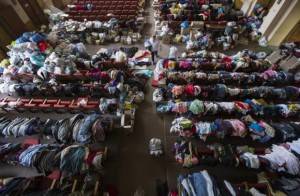Can Russia handle the flood of Ukrainian immigrants?
Milan, IULM University, Jan 19 (IPS) - According to official data released by the Russian Government, since April 2014 more than one million Ukrainian refugees have sought refuge in Russia. Despite these figures the Government has not acknowledged that there is a migrant crisis. Some Russian politicians have gone so far as to say that the international community should follow the Russian model in dealing with large numbers of refugees.
 A refugee camp set up by the Russian Emergencies Ministry for people displaced by fighting in Ukraine. Credit: REUTERS/Shamil ZhumatovInitially, the large numbers of refugees arriving in the south of Russia let to discord with local groups unused to high levels of diversity and ignorant of the refugee protocols. Nevertheless, the communities have attempted to provide help and support to migrants who need assistance. Ukrainian refugees were either placed in fully equipped refugee camps, in sanatoriums and schools or were placed in local homes. Refugees were accepted in many cities in Russia, such as; Rostov-on-Don, Krasnodar and Volgograd.
A refugee camp set up by the Russian Emergencies Ministry for people displaced by fighting in Ukraine. Credit: REUTERS/Shamil ZhumatovInitially, the large numbers of refugees arriving in the south of Russia let to discord with local groups unused to high levels of diversity and ignorant of the refugee protocols. Nevertheless, the communities have attempted to provide help and support to migrants who need assistance. Ukrainian refugees were either placed in fully equipped refugee camps, in sanatoriums and schools or were placed in local homes. Refugees were accepted in many cities in Russia, such as; Rostov-on-Don, Krasnodar and Volgograd.
The government of the Russian Federation has implemented changes in the law regarding the time parameters for issuing refugee documents that includes allowing for different lengths of stay in the country. The documentation provides either the status of refugee or temporary asylum seeker. The latter group allows the refugees residence in the country for an extended period of time. Initially, all refugees receive financial help. Thereafter they are given a choice of the region in which they wish to settle, since the south of Russia cannot permanently host large numbers refugees. The government then assists in providing shelter and assistance and in helping refugees to find employment.
One of the regions where refugees can settle is the Khanty-Mansy Autonomous District or KhMAO in Western Siberia. Work has been easier to find in this region due mainly to the thriving oil industry. Local government has also been providing financial assistance that includes a maternity allowance and produces information for immigrants on local laws. While these reforms have gone some way to assisting refugees, still more needs to be done to help them integrate in a sometimes difficult transition.
In general, the refugees in KhMAO have been well received by many Russians given the many similarities between the two cultures. Easing the integration of migrants has thus been aided not only by financial support but also support from the Russian people. Interaction between the two populations is highly important given that refugees have lost their homes, social groups and local culture. Currently, most refugees in khMAO have jobs and decent living conditions, as well as other benefits, such as free university and school access. In other words they have the right to a safe and decent life.
As with every political crisis, however, opposition is present especially due to differences between regional attitudes on the assumption of migrants. There are limited systematic directives from the government and no clear documentation stating refugee rights, which increase bureaucratic stress and difficulties for the refugees themselves when trying to acquire legal documents and in understanding deadlines for presenting documentation. This has tended to intensify between refugees and the state.
An increasing issue are high levels of unemployment levels due to the intake of a largely unskilled labour force. Nevertheless, the regions which take-in refugees are typically those with the greatest ability to absorb unskilled labour. For example, jobs in construction and production are in high demand, the problem arises when the refugees are highly educated and demand better job opportunities. Instead of randomly allocating refugees to certain locations, a database with specialist skills needs to be created which would allow for the selection and allocation of refugees based on their skills and experience, thus helping local economies and more closely approaching the expectations of the immigrants.
Russia lacks a proper policy for supporting and utilising effectively its refugees. Current programmes provide support for no more than two years, too little time for many to integrate adquately. In addition, there are no associations protecting and promoting refugee rights, with the main impact borne therefore by the local population. Since there is no separate government budget for the refugee crisis, taxes for local residents increase thus allowing the national economy to support these new population. Taken together with essentially static salaries and the current financial crisis, including progressively falling international oil prices, the burden falls on the local community to absorb the costs they incur. Some of those that have welcomed refugees have been unable to sustain these expenses.
Nor is the situation helped by the existence of corruption - often present in the form of costs associated with processing and releasing refugee documents. According to representatives from multiple NGOs, the Promorsky Krai Federal State Unitary Enterprise demands 78 000 rubles (around €1000) for "fast and trouble-free" document processing.
Many issues have accumulated over a short period of time due to the refugee crisis. To improve the situation with Ukrainian refugees before the crisis deepens, administrative measures need to be replaced by economic incentives and relocation procedures have to be reviewed, allowing for an easier redistribution of refugees throughout the country, that takes into account both the needs of the incoming populations and those of local communities.
(End)
© Inter Press Service (2016) — All Rights ReservedOriginal source: Inter Press Service
 Global Issues
Global Issues